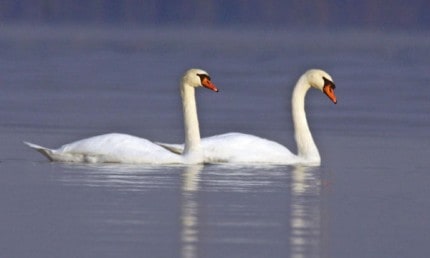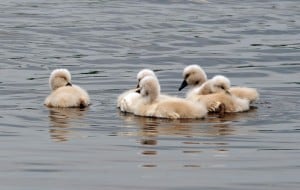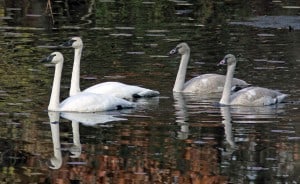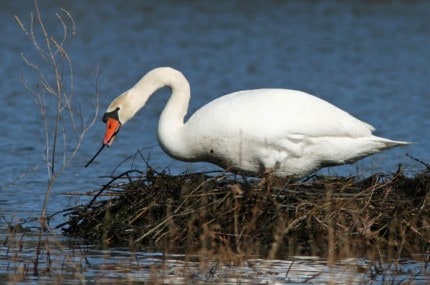
(Chelsea Update would like to thank Tom Hodgson and the Waterloo Natural History Association for the information and photos in this story.)
The mute swan with its bright white feathers and gracefully arching neck is a truly impressive bird. So much so, that in the late 1800’s, mute swans were brought to North America from Europe to adorn city parks and palatial estates.
According the Michigan DNR, the first pair of feral mute swans was introduced to Michigan in Charlevoix County in 1919. By the 1940’s that pair had grown to a flock of 47. By 1982, the state-wide mute swan population had grown to over 2,000.
Today, Michigan has over 15,000 mute swans, the most in North America. It’s hard to find a lake in the state without at least one nesting pair. Is that a bad thing? After all, they are beautiful birds.

As my grandmother used to say “pretty is as pretty does” (I think that line also appeared in the movie Forest Gump, and my grandmother got no credit for it). Some of the things that mute swans do are definitely not very pretty.
They are one of the most aggressive bird species in the world. They will vigorously defend their nesting territories, and not just from other mute swans. They have been known to attack geese and other waterfowl, jet skiers, kayakers and even swimming children. The flip side of that is they will tend to suppress the number of geese nesting on a given lake. Mill Lake in the Waterloo Recreation area is a good example. Prior to being claimed by a pair of mute swans one could count on finding five to seven goose nests along its shores each spring. Now one or two is more the norm. That would be good news for those who consider local geese a nuisance.
The Michigan DNR is concerned about the growing population of mute swans for three primary reasons. They are seen as a threat to public safety, to other wildlife and to wetland habitats. Although depressing the goose populations may be a plus, the negative impact on threatened species like loons and trumpeter swans is not. Mute swans are vegetarians. Each adult swan consumes from 4-8 pounds of aquatic vegetation per day.
There is concern that the ever growing mute swan population and the tons of vegetation consumed may be altering aquatic habitats to the detriment of other species.
The DNR has set an ambitious goal of eliminating all mute swans from public lands and reducing the state-wide numbers on private lands to less than 2,000 by 2030. To achieve this goal, it will be necessary to overcome some serious obstacles not the least of which may be the objections raised by those who enjoy seeing the birds.

Previous efforts to reduce mute swan populations including nest destruction; addling or oiling the eggs or replacing them with plastic eggs have been only marginally effective. Young mute swans have a very low survival rate, especially in Southern Lower Michigan where snapping turtles take most of the cygnets in their first week of life. Yet, the population continues to grow. The reason is the longevity of the adults. Once a mute swan reaches adulthood, it has few natural predators and can expect to live 10 years or more in the wild. Their low reproductive rate is more than compensated by their longevity.
So the key to reducing the mute swan population may be the culling of the adults, but how? Creating an open hunting season on mute swans would be tricky for a couple of reasons.
First, there would probably be a backlash from the non-hunting public.
Second, the endangered trumpeter swan that is trying to make a comeback in Michigan is almost identical to mute except for the color of the bill. The potential for miss-identification and the accidental shooting of this protected species is very real. We have had at least one successful breeding pair of trumpeter swans in the Waterloo Recreation Area in recent years.
Mute swans also go through a flightless period in June and July when they molt and replace their wing feathers. This would be the time to round them up, euthanize them and donate the meat to homeless shelters and soup kitchens. Being primarily vegetarians, their meat is probably quite good.
Whatever the outcome, the process is going to be messy, controversial, and difficult. Surely, the well-meaning individuals who first introduced mute swans into North America did not anticipate the long term consequences of their actions. Unfortunately, the problems resulting from unintended consequences are often the most difficult to solve.















Not for the first time the DNR has hold of the wrong end of the stick. Mute Swans are, and have been for a century, a welcome addition to the Michigan habitat. I did a Google search, and could find no record of the DNR receiving a tablet from a burning bush appointing them the decision maker on species allowed to thrive in Michigan.
We had a beautiful pair on Silver lake in Traverse City for several years and enjoyed watching their surviving offspring each of the last few years. They were so tame, even with their young they would swim up to our pontoon when we came on shore or even when we were out of the boat standing in the water and allowed us to hand feed them. The only aggression was when the jet ski folks would circle them and the male responded in trying to protect his family, the male was seen chasing a very specific jet ski a few times. There were complaints-later in the summer we noticed the female and her two remaining offspring alone one weekend and were saddened to hear the DNR shot the male in response to the complaints. Too bad more people didn’t complain about the guy on the jet ski taunting THEM. I WISH there had been a relocation plan for them.
My husband and I have been fortunate to watch the nesting Trumpeter swans up close and have seen the aggressive nature of the Mute swans toward the Trumpeter swans. We were thrilled to see this native species, Trumpeter swans, return to our area for two years in a row. We did not see them this year but the agressive Mute Swans came back in their place. Swans are beautiful, whether they have an orange bill or a black bill, but the black billed swan is the most serene. Hopefully they will be able to return to their natural habitat and grace us with their presence. Thank you Tom for your articles. P.S. The picture depicted of the Trumpeter Swans show the parents swimming in front and thier growing babies following them.